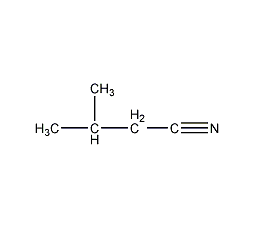
Structural formula
| Business number | 06RU |
|---|---|
| Molecular formula | C5H9N |
| Molecular weight | 83.13 |
| label |
Isobutyl cyanide, 3-Methylbutyronitrile, Isobutyl cyanide, 3-Methylbutanenitrile, Isomylnitrile, synthetic raw materials, Intermediates |
Numbering system
CAS number:625-28-5
MDL number:MFCD00001944
EINECS number:210-884-1
RTECS number:NY1750000
BRN number:1734239
PubChem number:24858675
Physical property data
1. Properties: colorless liquid[1]
2. Melting point (℃): -100.8[2]
3. Boiling point (℃): 130.5[3]
4. Relative density (water=1): 0.795[4]
5. Octanol/water partition coefficient: 1.07[5]
6. Flash point (℃): 28.33[6]
7. Solubility: Slightly soluble in water, easily soluble in acetone, miscible in ethanol and ether. [7]
Toxicological data
1. Acute toxicity: mouse (oral) LD50: 233 mg/kg; mouse (parenteral) LD50: 400 mg/kg; rabbit (subcutaneous) LDLo: 43,400 μg/kg; frog (subcutaneous) LDLo: 3,800 mg/kg; since the LD50 of table salt is 3,000 mg/kg, the acute toxicity of BPA is the same as that of table salt.
2. Acute toxicity [8] LD50: 233mg/kg (mouse oral)
Ecological data
1. Ecotoxicity No data available
2. Biodegradability No data available
3 .Non-biodegradability No information available
4. Other harmful effects[9] This substance is harmful to the environment and should be treated with special Pay attention to water pollution.
Molecular structure data
1. Molar refractive index: 25.08
2. Molar volume (cm3/mol): 104.8
3. Isotonic specific volume (90.2K ): 236.7
4. Surface tension (dyne/cm): 26.0
5. Polarizability (10-24cm3): 9.94
Compute chemical data
1. Reference value for hydrophobic parameter calculation (XlogP): None
2. Number of hydrogen bond donors: 0
3. Number of hydrogen bond acceptors: 1
4. Number of rotatable chemical bonds: 1
5. Number of tautomers: none
6. Topological molecule polar surface area 23.8
7. Number of heavy atoms: 6
8. Surface charge: 0
9. Complexity: 65.3
10. Number of isotope atoms: 0
11. Determine the number of atomic stereocenters: 0
12. Uncertain number of atomic stereocenters: 0
13. Determine the number of chemical bond stereocenters: 0
14. Number of uncertain chemical bond stereocenters: 0
15. Number of covalent bond units: 1
Properties and stability
1. Stability[10] Stable
2. Incompatible materials [11] Strong oxidants, strong reducing agents, strong acids
3. Conditions to avoid contact[12] Heating
4. Polymerization hazard[13] No Polymerization
5. Decomposition products[14] Cyanide
Storage method
Storage Precautions[15] Stored in a cool, ventilated warehouse. Keep away from fire and heat sources. Keep container tightly sealed. They should be stored separately from oxidants, reducing agents, acids, and food chemicals, and avoid mixed storage. Use explosion-proof lighting and ventilation facilities. It is prohibited to use mechanical equipment and tools that are prone to sparks. The storage area should be equipped with emergency release equipment and suitable containment materials.
Synthesis method
None
Purpose
Used in organic synthesis. [16]


